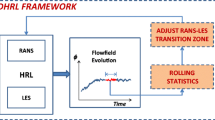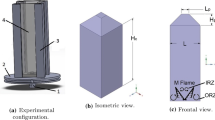Abstract
Modelling the complete flow physics and chemical kinetics of supersonic combustion is a particularly complex and daunting task that requires significant computational resources. To foster performance evaluation tools for future hypersonic vehicles, develo** accurate yet computationally efficient solution methods is of great importance. In this work, a new subgrid combustion model for large eddy simulations is derived and used in a three-dimensional in-house flow solver to provide simulations of experimental scramjet ground tests. In particular, this paper introduces a hybrid model closure with the reaction-rate approach to close the filtered chemical source terms in the governing equations for species mass fractions and total energy. The model developed here makes use of a linear bridging function, depending on the segregation rate of the mixture fraction, between a resolved contribution issued from a perfectly stirred reactor (PSR) estimation, and a subgrid-scale (SGS) contribution where a closure that approximates the Lagrangian trajectory in the composition space is retained. The new model considers the effect of fluctuations of compositions and can be extended to take into account, for example, the fluctuations of temperature. The new approach is tested using a hydrogen-fueled scramjet combustor from circular injector into a Mach 2 vitiated airflow for total pressure and temperature of 0.40 MPa and 1695 K, respectively. The selected operating conditions are representative of the LAPCAT-II dual-mode ramjet/scramjet combustion. Chemistry is described using a four-step reduced mechanism. The results obtained with the present modelling proposal are compared to those issued from numerical simulations performed with the quasi-laminar chemistry or PSR approach. These results do show that, even for a highly resolved computational mesh, the effects of composition fluctuations remain significant, especially in the vicinity of the injection where the SGS fluctuations of the scalar field are non-negligible.















Similar content being viewed by others
References
Pandey RJ, Kim SH, Kim KY (2021) Analysis of interaction between oscillating jet issuing from a fluidic oscillator and a crossflow. Int J Aeronaut Space Sci 22(2):255–263
Gamba M, Mungal MG (2015) Ignition, flame structure and near-wall burning in transverse Hydrogen jets in supersonic crossflow. J Fluid Mech 780:226–273
Liu C, Yu J, Wang Z, Sun M, Wang H (2019) Characteristics of hydrogen jet combustion in a high-enthalpy supersonic crossflow. Phys Fluids 31(4):046105
Song Y, Hwang D, Ahn K (2019) Effect of orifice geometry on column trajectories of liquid jets in crossflows. Int J Aeronaut Space Sci 20(1):139–149
Menon S, Yeung PK, Kim WW (1996) Effect of subgrid models on the computed interscale energy transfer in isotropic turbulence. Comput Fluid 25(2):165–180
Zheng LL, Bray KNC (1994) The application of new combustion and turbulence models to \({{\rm H}}_2\)-air nonpremixed supersonic combustion. Combust Flame 99(2):440–448
Sabel’Nikov V, Deshaies B, da Silva LFF (1998) Revisited flamelet model for nonpremixed combustion in supersonic turbulent flows. Combust Flame 114(3–4):577–584
Watanabe J, Kouchi T, Takita K, Masuya G (2013) Characteristics of hydrogen jets in supersonic crossflow: large-eddy simulation study. J Propul Power 29(3):661–674
Ben-Yakar A, Mungal MG, Hanson RK (2006) Time evolution and mixing characteristics of Hydrogen and Ethylene transverse jets in supersonic crossflows. Phys Fluids 18(2):026101
Techer A (2017) Simulation aux grandes échelles implicite et explicite de la combustion supersonique. Dissertation, Chasseneuil-du-Poitou, École Nationale Supérieure de Mécanique et d’Aérotechnique
Shamooni A, Cuoci A, Faravelli T, Sadiki A (2018) Prediction of combustion and heat release rates in non-premixed syngas jet flames using finite-rate scale similarity based combustion models. Energies 11(9):2464
Hirschfelder JO, Curtiss CF, Bird RB (1964) Molecular theory of gases and liquids. Wiley, New Jersey
Lee S (1993) Large eddy simulation of shock turbulence interaction. Center for Turbulence Research, Annual Research Briefs, pp 73–84
Vreman B, Geurts B, Kuerten H (1995) A priori tests of large eddy simulation of the compressible plane mixing layer. J Eng Math 29(4):299–327
Nicoud F, Ducros F (1999) Subgrid-scale stress modelling based on the square of the velocity gradient tensor. Flow Turbul Combust 62(3):183–200
Meneveau C, Lund TS, Cabot WH (1996) A Lagrangian dynamic subgrid-scale model of turbulence. J Fluid Mech 319:353–385
Stull DR, Prophet H (1971) JANAF thermochemical tables. Technical report, National Standard Reference Data System
Balsara DS, Shu CW (2000) Monotonicity preserving weighted essentially non-oscillatory schemes with increasingly high order of accuracy. J Comput Phys 160(2):405–452
Adams NA, Shariff K (1996) A high-resolution hybrid compact-ENO scheme for shock-turbulence interaction problems. J Comput Phys 127(1):27–51
Ducros F, Ferrand V, Nicoud F, Weber C, Darracq D, Gacherieu C, Poinsot T (1999) Large-eddy simulation of the shock/turbulence interaction. J Comput Phys 152(2):517–549
Gottlieb S, Shu CW (1998) Total variation diminishing Runge–Kutta schemes. Math Comput Am Math Soc 67(221):73–85
Boivin P, Sánchez AL, Williams FA (2013) Four-step and three-step systematically reduced chemistry for wide-range \({{\rm H}}_2\)-air combustion problems. Combust Flame 160(1):76–82
Conaire Ó, M, Curran MJ, Simmie JM, Pitz WJ, Westbrook CK (2004) A comprehensive modeling study of hydrogen oxidation. Int J Chem Kinet 36(11):603–622
Boivin P, Jiménez C, Sánchez AL, Williams FA (2011) An explicit reduced mechanism for \({{\rm H}}_2\)-air combustion. Proc Combust Inst 33(1):517–523
Borghi R (1975) Computational studies of turbulent flows with chemical reaction. Turbulent mixing in nonreactive and reactive flows. Springer, Berlin, pp 163–188
Yamashita H, Shimada M, Takeno T (1996) A numerical study on flame stability at the transition point of jet diffusion flames. In: Symposium (International) on Combustion, volume 26, pp 27–34, Elsevier
Obounou M, Gonzalez M, Borghi R (1994) A Lagrangian model for predicting turbulent diffusion flames with chemical kinetic effects. In Symposium (International) on Combustion, vol 25, pp 1107–1113
Vincent-Randonnier A, Moule Y, Ferrier M (2014) Combustion of Hydrogen in hot air flows within LAPCAT-II Dual Mode Ramjet combustor at Onera-LAERTE facility-experimental and numerical investigation. In 19th AIAA international space planes and hypersonic systems and technologies conference, pp 2932
Nastac G, Labahn JW, Magri L, Ihme M (2017) Lyapunov exponent as a metric for assessing the dynamic content and predictability of large-eddy simulations. Phys Rev Fluids 2(9):094606
Pope SB (2001) Turbulent flows. Cambridge University Press, Cambridge
Yoshizawa A (1986) Statistical theory for compressible turbulent shear flows, with the application to subgrid modeling. Phys Fluids 29(7):2152–2164
Celik IB, Cehreli ZN, Yavuz I (2005) Index of resolution quality for large eddy simulations. J Fluids Eng 127(5):949–958
Pettit MWA, Coriton B, Gomez A, Kempf AM (2011) Large-eddy simulation and experiments on non-premixed highly turbulent opposed jet flows. Proc Combust Inst 33(1):1391–1399
Lu T, Law CK (2009) Toward accommodating realistic fuel chemistry in large-scale computations. Prog Energy Combust Sci 35(2):192–215
Duwig C, Nogenmyr KJ, Chan CK, Dunn MJ (2011) Large eddy simulations of a piloted lean premix jet flame using finite-rate chemistry. Combust Theor Model 15(4):537–568
Gonzalez M, Borghi R (1991) A Lagrangian intermittent model for turbulent combustion; theoretical basis and comparisons with experiments. In: Turbulent shear flows, pp 7293–7311
Villermaux J, Devillon JC (1972) Représentation de la coalescence et de la redispersion des domaines de ségrégation dans un fluide par un modele d’interaction phénoménologique. In: Proceedings of the 2nd international symposium on chemical reaction engineering, 26, pp 1–13
Bridel-Bertomeu T, Boivin P (2015) Explicit chemical timescale as a substitute for tabulated chemistry in a \({{\rm H}}_2\)-\({{\rm O}}_2\) turbulent flame simulation. Combust Sci Technol 187(5):739–746
Author information
Authors and Affiliations
Corresponding author
Ethics declarations
Conflict of interest
The authors declare that they have no conflict of interest.
Additional information
Publisher's Note
Springer Nature remains neutral with regard to jurisdictional claims in published maps and institutional affiliations.
Appendix: MIL Model
Appendix: MIL Model
For the sake of completeness, a brief description of the \(\texttt {MIL}\) turbulent combustion modelling framework is now provided. From a general point of view, it has been previously established to be robust, easy to implement, and it features small computational costs [36]. The MIL model is a Lagrangian model in the composition space which is based on the knowledge of two scalar variables, namely the mixture fraction \(\xi \) and a progress variable \(Y_c\) which follows the departures from chemical equilibrium, i.e., the progress of the chemical reaction. Based on the simplest micromixing closure, i.e., the one given by the IEM (Interaction par Echange avec la Moyenne) model of Villermaux & Devillon [37], the Lagrangian evolution of fluid particles issuing from either oxidizer or fuel stream is given by the following set of equations
The MIL model relies on the sudden chemistry assumption: it is assumed that Lagrangian particles first need a finite time to ignite and, after ignition occurred, they instantaneously reach chemical equilibrium conditions. This permits a strong but clearly stated functional dependence between the two scalars to be introduced: \(Y_c=Y_c^{\texttt {MIL}}(\xi )\). As a result, the SGS joint scalar probability density function \(\widetilde{\texttt {PDF}}({Y_c},\xi ;{\varvec{x}},t)\) can be simply expressed from the single knowledge of the SGS marginal mixture fraction PDF since we have \(\widetilde{\texttt {PDF}}({Y_c},\xi ;{\varvec{x}},t)=\widetilde{\texttt {PDF}}(\xi ;{\varvec{x}},t)\texttt {PDF}({Y_c} | \xi ;{\varvec{x}},t)\) where the conditional \(\texttt {PDF}({Y_c} | \xi ;{\varvec{x}},t)\) is obtained by considering the MIL trajectory in the composition space: \(\texttt {PDF}({Y_c}|\xi ;{\varvec{x}},t) = \delta ({Y_c}-Y_c^{\texttt {MIL}}(\xi ))\). A classical \(\beta \)-function is retained to estimate the marginal mixture fraction \(\widetilde{\texttt {PDF}}(\xi ;{\varvec{x}},t)\) while the conditional \(\texttt {PDF}({Y_c} | \xi ;{\varvec{x}},t)\), i.e., the Lagrangian trajectory as given by \(\delta ({Y_c}-Y_c^{\texttt {MIL}}(\xi ))\), is fully determined from the single knowledge of the two jump (or ignition) positions \(\xi _{J^{-}}\) and \(\xi _{J^{+}}\) (cf. Fig. 16). The corresponding values are obtained from a direct comparison between the mixing time scale \(\tau _\texttt {SGS}\) and chemical time scales, which have been tabulated as a function of the mixture fraction, i.e., \(\tau _{\text {chem}}(\xi )\), thus reflecting the competition that may exist between chemical reaction and scalar mixing. Once the joint \(\widetilde{\texttt {PDF}}({Y_c},\xi ;{\varvec{x}},t)\) is estimated, the mean chemical production rate reads
with the instantaneous chemical production rate \(\omega _{Y_c}^{\texttt {MIL}}\) deduced from the Lagrangian trajectory
The pre-tabulation of the chemical characteristic time scale is presently replaced by an analytical estimate based on the expression of the reactivity \(\lambda \) as given by Eq. (11), which is evaluated using the local composition and temperature. According to Bridel-Bertomeu & Boivin [38], this should allow for a significant reduction of the computational costs.
Rights and permissions
About this article
Cite this article
Boukharfane, R., Techer, A. & Er-raiy, A. LES of Reacting Flow in a Hydrogen Jet into Supersonic Crossflow Combustor Using a New Turbulent Combustion Model. Int. J. Aeronaut. Space Sci. 23, 115–128 (2022). https://doi.org/10.1007/s42405-021-00424-5
Received:
Revised:
Accepted:
Published:
Issue Date:
DOI: https://doi.org/10.1007/s42405-021-00424-5





